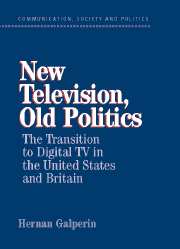Book contents
- Frontmatter
- Contents
- List of Figures and Tables
- Preface and Acknowledgments
- List of Acronyms and Abbreviations
- PART I A POLITICAL ECONOMY OF DIGITAL TV
- PART II THE AMERICAN ROAD TO DIGITAL TV
- 3 The Genesis of Broadcast Regulation in the United States
- 4 HDTV Comes to America
- 5 A New Bargain
- 6 A Long Journey
- PART III THE BRITISH ROAD TO DIGITAL TV
- PART IV NEW TELEVISION, OLD POLITICS
- References
- Index
4 - HDTV Comes to America
from PART II - THE AMERICAN ROAD TO DIGITAL TV
Published online by Cambridge University Press: 24 July 2009
- Frontmatter
- Contents
- List of Figures and Tables
- Preface and Acknowledgments
- List of Acronyms and Abbreviations
- PART I A POLITICAL ECONOMY OF DIGITAL TV
- PART II THE AMERICAN ROAD TO DIGITAL TV
- 3 The Genesis of Broadcast Regulation in the United States
- 4 HDTV Comes to America
- 5 A New Bargain
- 6 A Long Journey
- PART III THE BRITISH ROAD TO DIGITAL TV
- PART IV NEW TELEVISION, OLD POLITICS
- References
- Index
Summary
The American transition to digital TV grew out of political maneuvering by incumbent local broadcasters in the mid-1980s in defense of the industry arrangements sanctioned by the Sixth Report of 1952. As discussed, the report inaugurated the intermixture policy whereby both VHF and UHF stations were licensed in the same market, putting UHF stations at great technical disadvantage. As a result, UHF stations struggled, and many frequency channels reserved for UHF broadcasting remained unused (Hazlett and Spitzer, 2000). In 1985 a number of parties petitioned the FCC to relax restrictions on the sharing of UHF channels by land mobile operators. The coalition was led by Motorola, which manufactured the two-way radios used by land mobile operators such as public safety organizations and commercial delivery companies. Since the early 1970s, land mobile and analog TV had been sharing a small portion of the UHF spectrum (channels 14–20). The coalition demanded that the sharing agreement be extended to other unused UHF channels and that interference-prevention rules be relaxed.
Incumbent broadcasters vehemently opposed the proposal. However, a credible claim was needed to prevent police departments and ambulances from utilizing frequencies that essentially lay unused. Otherwise, local broadcasters were headed for a public relations disaster. NAB executives considered different options and eventually decided on a course of action that hinged on the argument that these frequencies needed to be preserved for the impending deployment of advanced television services, including HDTV.
- Type
- Chapter
- Information
- New Television, Old PoliticsThe Transition to Digital TV in the United States and Britain, pp. 71 - 89Publisher: Cambridge University PressPrint publication year: 2004

